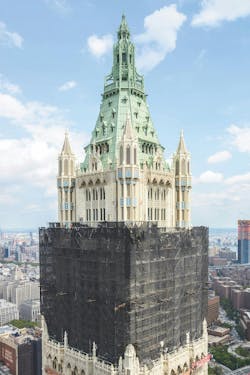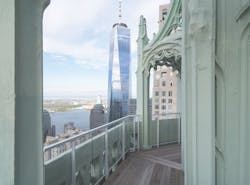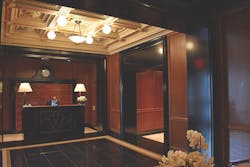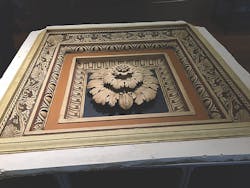Woolworth Tower Residences: What a view!
Upon its completion, in 1913, the Woolworth Building was the tallest building in the world. Designed by Cass Gilbert (1859-1934), the 62-story, 792-foot Neo-Gothic skyscraper at 233 Broadway, New York, held that honor until 1930.
Now, more than a century later, it is being cited for the extraordinary effort by construction manager CNY and its project team in converting its upper tower into 31 luxury residences and one enormous penthouse, a five-story “townhome in the sky.”
The CNY team restored the landmark terra cotta façade, including turrets, decorative features, and metalwork; replaced and upgraded the MEP infrastructure; constructed a new separate entrance, lobby, and two new private elevators to serve the new residences on floors 29 to 50; and added a host of modern amenities: wine storage, a yoga studio, swimming pool, Jacuzzi, sauna, secure bicycle storage, a fitness center, and a lounge-gaming center with a pantry.
All this work had to be done in three around-the-clock shifts without the use of a crane or hoist tower on the outside of the building. Everything had to be hoisted up through existing shaftways within the guts of the building, even as the lower 28 floors were occupied with commercial tenants.
The only available access to the upper floors was through two decommissioned side-by-side elevators in which a temporary hoist cab that measured a mere 4½x9x9 feet was installed.
Oversized equipment like fans, cooling tower components, and pumps were purchased as knockdowns, enabling them to be fabricated, disassembled into smaller pieces, hoisted up, and reassembled in place. Steel section beams were cut into six-foot sections, hoisted to the 50th floor, winched up four more stories to the penthouse using a chain fall and pulleys, and reassembled and welded.
This amazing feat of structural and mechanical engineering and construction was achieved by removing four elevators, truncating three more, and gutting the core to construct two new large-core elevator shafts and stairwells—an operation that took two years to complete.
Construction of the five-story penthouse, known as the Pinnacle, required major demolition and gut renovation. The space originally housed the building’s MEP/FP systems and domestic water tanks. To replace these outdated systems, the project team had to field design and install a new 15,000-gallon water tank beneath the roof, a new fire pump 10 stories down, and a 3,500-gallon tank 20 stories down. Only then could the old tanks and equipment be removed. A new circular stairwell was constructed through the center of the donut-shaped tank.
As befits a National Historic Landmark (1966) and New York City Landmark (1983), no two floors and no two rooms in the Woolworth were exactly the same. The distinct floor-to-floor heights, differing beam depths at the ceilings, and drifting historical columns at the core complicated the stacking of the units. The diminishing size of the floor plates in the tower, coupled with the unique requirements of extremely discriminating buyers, added to the complexity of the design.
Sculptural arches, gargoyles, and terra cotta rosebuds were restored as a critical component of the customized framing of every window. About 7,500 tons of cream terra cotta with blue and yellow glazed accents were meticulously preserved or recreated, using over 30 different molds to match the landmark color aesthetic, at a cost of $23 million.
To revive the original 55x15-foot basement lap pool, CNY had to remove, inventory, and reposition 34 solid marble coping stones weighing 800 lbs each.
As a finishing touch, CNY relocated the original coffered ceiling in F.W. Woolworth’s office on the 40th floor—400 sf of 3x3-foot, 100-pound blue, white, and gilded/bronzed plaster panels—to a dedicated residential entrance lobby.
PLATINUM AWARD WINNER
BUILDING TEAM CNY (submitting firm, CM) BlackRock (owner) The Office of Thierry W Despont Ltd. (architect, interior architect) SLCE Architects LLP (architect of record) Gilsanz Murray Steficek LLP (SE) AKF Engineers LLP (MEP) DETAILS 150,211 sf Total cost Confidential at owner’s request Construction time January 2016 to December 2018 Delivery method CM



